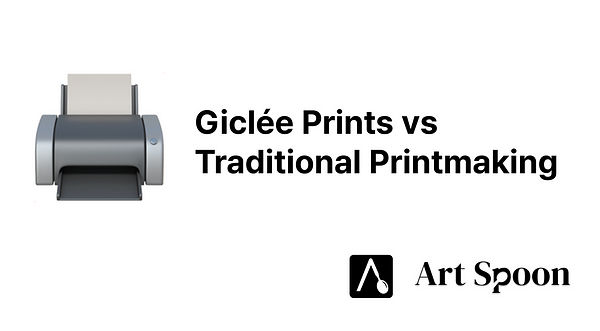Giclee Prints vs Traditional Printmaking: Which is Best for Your Art?
Tips
|
2024. 08. 06.

When it comes to reproducing artwork, choosing between Giclee prints and traditional prints is crucial for artists. Both methods have unique advantages, but understanding the differences can help you make an informed decision. Let’s dive into the key distinctions between Giclee prints and traditional prints.
What are Giclee Prints?
Giclee prints are high-quality reproductions made using an inkjet printer. The term “giclée” comes from the French word “gicler,” meaning “to spray.” This technique involves spraying microscopic dots of pigment-based ink onto high-quality paper or canvas, resulting in vibrant, detailed, and long-lasting prints.
What are Traditional Prints?
Traditional prints refer to various printing methods used for centuries, including lithography, screen printing, and etching. These techniques involve transferring ink from a plate, screen, or stone onto paper, often requiring manual labor and specific skills.
Key Differences
1. Quality and Detail
Giclee prints:
- Offer exceptional detail and color accuracy.
- Use high-resolution digital files and archival-quality inks.
- Result in prints that closely resemble the original artwork, capturing even the most subtle nuances.
Traditional prints:
-
Vary in quality depending on the technique and materials used.
-
May lack the fine detail and color precision of Giclee prints.
-
Each piece may have slight variations, which can add a unique character but might not be ideal for precise reproductions.
2. Longevity
Giclee prints:
- Use fade-resistant, pigment-based inks that are designed to last.
- Can last for decades without significant color degradation, especially when printed on archival-quality paper or canvas.
- Suitable for collectors and museums due to their durability.
Traditional prints:
-
Longevity varies by method and materials used.
-
Some traditional prints may fade or degrade faster than Giclee prints, depending on the ink and paper quality.
-
Often require careful handling and specific environmental conditions to preserve their quality.
3. Production Process
Giclee prints:
- Created using advanced inkjet printers capable of producing extremely fine details.
- Allow for precise control over color and detail, making them ideal for reproducing photographic and digital artworks.
- Suitable for limited runs or single prints without the need for extensive setup.
Traditional prints:
-
Often involve labor-intensive manual processes, including preparation of plates, screens, or stones.
-
Can be time-consuming and require specific skills and expertise.
-
Better suited for larger print runs due to the high initial setup costs, but unit costs decrease with volume.
4. Cost
Giclee prints:
- Cost-effective for short runs or individual prints, as there are no significant setup costs.
- Typically more expensive per print compared to mass-produced traditional prints but offer higher quality.
- Ideal for artists who want to produce limited editions or one-of-a-kind prints without a large initial investment.
Traditional prints:
-
Economical for large print runs due to lower per-unit costs once the setup is complete.
-
Initial setup costs can be high, especially for techniques like lithography or etching.
-
Best suited for artists or publishers planning to produce large quantities of prints.
Why Choose Giclee Prints?
For artists looking for high-quality, durable, and precise reproductions of their work, Giclee prints are an excellent choice. They provide unmatched detail and color fidelity, ensuring that your art looks its best. The longevity and archival quality make them suitable for both sales and exhibitions.
Why Choose Traditional Prints?
Traditional prints can be ideal for artists who appreciate the craftsmanship and unique qualities of manual printing techniques. They offer a tactile, hands-on approach to art reproduction, and the variations in each print can add to the artwork’s character. These prints are perfect for larger production runs and those who enjoy the traditional methods of printmaking.
Conclusion
Both Giclee and traditional prints have their place in the art world. Your choice will depend on your specific needs, budget, and artistic vision. If you’re looking to create stunning, long-lasting reproductions of your work, Giclee prints are a fantastic option. For those who value the traditional methods and are producing larger quantities, traditional prints offer unique benefits.
How Art Spoon Can Help You
At Art Spoon, we support artists in showcasing their work with the best tools and services. Here’s how Art Spoon can assist you:
-
Professional Profile Creation: Easily create a stunning profile to showcase your Giclee prints.
-
Artwork Management: Synchronize your artwork list by simply entering a URL, making it easy to keep your portfolio updated.
-
Flexible Privacy Settings: Choose to make your artwork fully public, available to galleries only, or keep it private.
-
Feature Opportunities: With six or more public works and a well-prepared CV, get featured and have your online marketing managed by Art Spoon.
-
Affordable Subscription Fees: Enjoy the world’s lowest subscription fees, ensuring that you can access all these benefits without breaking the bank.
Join Art Spoon today to create your professional profile, manage your artwork, and reach a broader audience with ease. Whether you’re producing Giclee prints or traditional prints, Art Spoon has the resources and platform to help you succeed.